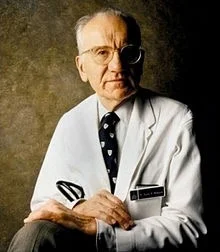Victor McKusick
1921 - 2008
The Father of Medical Genetics
I was a medical student, medical resident and faculty member at the Johns Hopkins School of Medicine in the 60s and 70s. During that time, Victor McKusick was Professor of Medicine there. Must of us, if not all, were in awe of him. He not only knew everything there was to know about human genetics and genetic-related diseases, but he seemed to know everything about a lot of other topics as well. I remember an incident during a time I was doing an elective project in cardiology. I was learning how to use a special device for recording and analyzing heart sounds called a spectral phonocardiograph. One day Dr. McKusick happened by and gave me a few pointers on how to use the equipment. When he left, the head of the laboratory told me that he was the one who had invented the technology!
On Dr. McKusick's days in the clinic, the waiting room would be filled with a mixture of Amish (who had a high incidence of genetic disorders because of inbreeding), dwarfs, and all variety of people with genetic disorders and genetic variations. We now know that of the 3 billion nucleotides that make up the human genome, only 0.1% of them account for all the variation we see in humans. Dr. McKusick studied these variations, published voluminously about them and created in the 1960s a database of all known genetic abnormalities in humans. Because of this work, he is often referred to as "the father of medical genetics."
My path intersected again with Dr. McKusick's greatness during the journey for this book. His database grew over the years and went through 12 book editions. In 1998, it was converted to an online database by the National Center for Biotechnology Information and is now called the Online Mendelian Inheritance in Man (OMIM). Researchers from all over the world contribute to this online resource which is still maintained by the Johns Hopkins School of Medicine. It contains descriptions of over 5,500 medical conditions with a known genetic basis including the detailed nucleotide sequence and chromosome location of over 3,400 gene mutations.
Genetic engineering, one of the main possible pathways to the answers described in the book, depends first on understanding which genes cause which disorders. It starts with OMIM.
Click on links to other players in my journey below.
Ardi * Aubrey de Grey * Bill Joy * C. Owen Lovejoy * Carl Linneaus * Charles Darwin * CRISPR *
Daniel E. Koshland, Jr * Elizabeth Kolbert * Ernst Mayr * Eugene E. Harris * Gregor Mendel * Henry Markram *
Ian Tattersall * Jean-Baptiste Lamarck * John Markoff * Katherine Pollard * Kevin de Queiroz * Lucy *
McBrearty and Brooks * Miguel Nicolelis * Paul Allen * Paul Berg * R.A.Fisher * Scott Blois * Singularity *
Stephen Jay Gould * Svante Pååbo * Sydney Brenner * Terry Sejnowski * Theodosius Dobzhansky *
